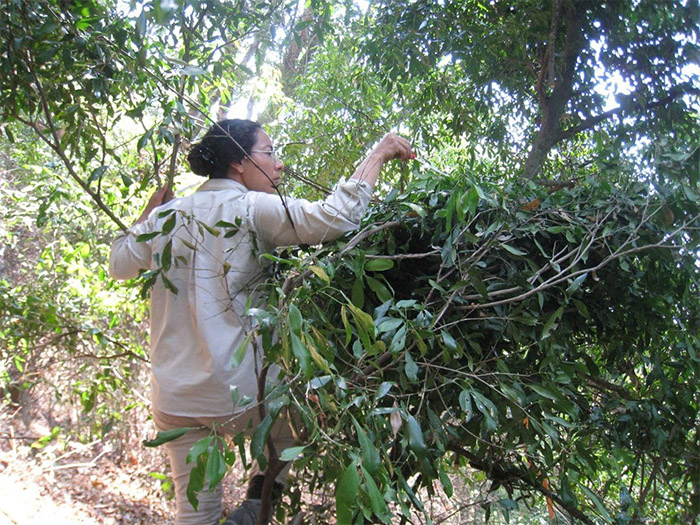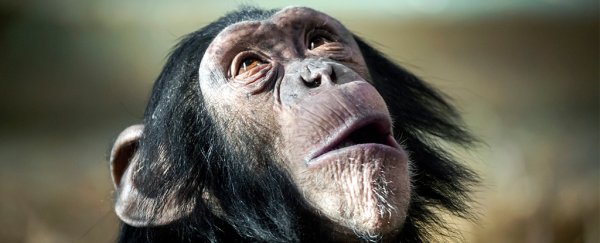We all have our nightly rituals: A nightcap and a bestseller, a vigorous floss, a last compulsive scroll through Twitter. Chimpanzees, our closest genetic relatives, have their bedtime habits, too.
Every evening, a chimp makes a new bed, in the literal sense, weaving branches and sticks into baskets that hang as high as 30 feet above the forest floor.
Humans who have slept in these nests, like anthropologist Fiona Stewart, describe them as cramped but effective wards against predators and bloodsuckers.
For the first time, scientists have probed the nests to see what sort of insects, other creepy-crawlies and microbes share a chimpanzee's bedding. The researchers say they wanted to compare wild-nest inhabitants with bugs of a more familiar sort - meaning what skitters or lurks between our sheets.
The chimpanzee lifestyle, with regard to their microbes, "is probably a good match for our ancestral exposures," said Rob Dunn, a North Carolina State University biologist.
"You have heard of paleo dieting. We were trying to get a sense of what paleo bedding was like."
Dunn and his co-authors report in a new paper, published in the journal Royal Society Open Science, that the chimpanzee bed ecosystem does not mirror the human version.
"As we've moved into these more urban, permanent, sealed environments, we've lost a lot of the diversity of species" to which people once were exposed, said Megan Thoemmes, a graduate student in Dunn's lab who studies the evolutionary history of face mites and other mammal-dwelling organisms.
"But nobody had ever really looked at how that may have varied compared to our past. Or to other mammals currently."
The last direct human relative to sleep in trees did so around 2 million years ago, after which Homo erectus began to slumber on the ground. Archaeological evidence suggests that our older ancestors snoozed in nests much like today's primates.
Many of the largest living primates, such as gorillas and orangutans, also build elevated platforms because tree branches alone can't support the weight of great apes.
In the new study, Thoemmes, Stewart, Dunn and their colleagues decided to study chimpanzees in part because they share all but 1.2 percent of human DNA. Chimpanzee parasites are well documented, as is their microbiome, the collection of microscopic organisms that call chimp bodies home.
 Adriana Hernandez-Aguilar swabs a leaf in a chimpanzee nest (Fiona Stewart)
Adriana Hernandez-Aguilar swabs a leaf in a chimpanzee nest (Fiona Stewart)
The researchers swabbed 41 recently abandoned nests in a Tanzanian forest to hunt for microbes. At 15 nests, they scooped up arthropods - insects, spiders and other invertebrates - using a handheld insect vacuum. They also vacuumed a square of jungle floor beneath the trees to compare the nest arthropods with what is normally found in the forest.
Only four of the nest arthropods were known chimp parasites. And none of these invertebrates specialized in feeding on chimpanzees. "Our data would suggest that they're really quite good at grooming each other and cleaning off ectoparasites," Thoemmes said.
Not so much for humans. As we sleep, we slough off dead skin and other body bits. And then the feast begins. "We fall apart in bed, and the wilderness comes to devour what has fallen," Dunn said, referring to face mites, dust mites and predatory mites.
Skin, oral, fecal and vaginal bacteria also colonize our beds. Philip Tierno, a microbiologist at New York University who was not involved with this research, called the microbial difference between chimp and human bedding "remarkable."
Human beds are rife with microbes associated with us. Chimpanzee nests were much richer in microbial diversity, with most of those germs coming not from their bodies but from the forest environment.
Tierno's research, which has involved ripping open mattress cores, has revealed "unbelievable amounts of debris." (Beyond mites, fungi, secretions and skin flakes, there are food particles with folks who eat in bed.) A mattress that has been slept on for a decade, Tierno said, is demonstrably heavier than a mattress fresh from the factory.
Along with that debris come bacteria. Our mouths and skin provide more than 30 percent of the bacteria on our pillowcases, according to a 2013 study in the journal PLOS One.
"The microbes we found on pillowcases are similar in composition to toilet seats, which in turn are most similar to the microbes on and in our human bodies," said Holly Menninger, a co-author with Dunn of that 2013 study and now a director at the University of Minnesota's Bell Museum of Natural History.
In chimpanzee nests, bacteria associated with primates had a minimal presence. Only 3.5 percent of the microbial DNA sequences were associated with chimpanzee bodies.
That's not what the scientists predicted. Consider the pungency of a zoo's primate house, Dunn said. The odor of a chimpanzee exhibit is "entirely due to the body microbes of the chimps," particularly the bacteria that live in chimp armpits.
"We expected to find those" in the nests, he said, but in the wild, their presence was lighter - just a "faint hint o' chimp."
The study authors also expected to find fecal microbes in high numbers because prior studies had shown that chimpanzees get stool stuck in their fur. In fact, chimpanzee fecal bacteria were rarely detected.
"They may just be really good at keeping fecal matter, when they poop over the sides of the nests, from getting into the bed," Thoemmes said.
It's true that fecal germs accumulate in human beds over time. But Tierno said a comparison between our bedding and chimp nests in this regard isn't fair to humans.
If chimps spent years and years in their bedding, the microbiologist expects "they would get more than environmental organisms" in their nests, too. He recommends encasing mattresses and pillows in anti-allergy barriers - all of the bedding in his house is - to prevent debris permeating where we sleep.
If you aspire to sleep the sweet sleep of the chimpanzee, recognize it is not really an attainable goal. Unless you live in an Ikea warehouse, humans don't have the luxury of constructing a new place to sleep every night.
2018 © The Washington Post
This article was originally published by The Washington Post.
